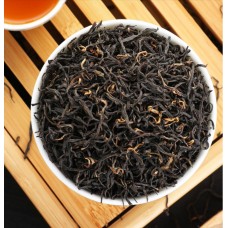Qi Men Black Tea, Hong Cha, Keemun Black Tea
Ex Tax: $19.00
Name: 'Qi Men Hong Cha' Chinese Keemun Black Tea
Origin : Anhui, China
Grade : Good
Storage : stored in a dry place and no direct sunshine
Suggested Usage: Take 2g to 3g of this product and infuse with boiled water. Then it can be served.
About Qi Men Hong Cha
Keemun, Qi Men Red Tea, from a former county of Keemun in Anhui Province, was once the popular "English Breakfast Tea". It is the best known of the north China Congous. There are various grades of Keemun such as Mao Feng, Hao-Ya, and Ji Hong. Keemun contains a substance called myrcenal. This is an essential oil that is unique only to the variety of tea plant from which Keemun tea is produced and which gives it a distinctive taste. It is said that it has a flavor that almost sings!
Black tea is also known as "Congous" in the international tea trade business. The name Congous is actually taken from the Chinese term Gongfu or Kung-Fu. Northern Congous are also referred to as black leaf Congous, "the Burgundy of China teas", and southern Congous as red leaf Congous, "the Claret of China teas".
Black tea leaves come from the same tea plant, Camellia sinensis as does all real tea, but probably the best comes from the Assam subvariety of the plant, Camellia sinensis Assamica, or a hybrid. The infused leaf is a reddish copper color and the liquor is bright red and slightly astringent but not bitter. The important difference is in the processing of the tea leaves, which makes black tea different from the other kinds of tea.
Black tea's caffeine is approximately 3 %, which is the highest of all the different kinds of tea, but still lower than coffee.
Making China Black Tea
The first step after plucking the leaves is to let them wither. Then there are three additional processing steps that the leaves are subjected to before becoming black tea. They are rolled, allowed to fully oxidize (ferment), and lastly they are dried. Also note, that after rolling, they are also sifted to separate the different leaf / leaf particle sizes.
- Rolling - The purpose of this step is to actually break open the surface of the leaves. This allows the remaining moisture, sap, if you will, in the leaves to escape and coat the surface of the leaves. This sap is what contains the polyphenols (formerly known as "tannins").
- Oxidation - When exposed to the air (oxygen) and under controlled conditions of heat and humidity, some of the polyphenols are oxidized ("fermented") by an enzyme called polyphenol oxidase. These then combine with other poyphenols to form compounds called theaflavins, which gives the leaves a bright coppery red color. Likewise, the theaflavins react with other compounds to form thearubigins. These ultimately render the leaves their final dark brown / black color. The theaflavins are associated with the "brisk" flavor and brightness of black tea, whereas the tea's strength and color are attributed to the thearubigins. At the completion of the oxidation (usually a few hours), the aroma of the leaves also changes from a "leafy" smell to a "fruity" one.
- Drying / Firing - Finally they are dried / fired, which stops the oxidation process. It also turns the leaves to their characteristic black color.
Write a review
Your Name:Your Review: Note: HTML is not translated!
Rating: Bad Good
Enter the code in the box below:



